Kate Kern is a visual artist who works primarily in drawing, although her work ranges from making artist books to installations, as well as an occasional curatorial endeavor. In 2013, she curated “Wounded Home” at the Lloyd Library and Museum, and was also a featured artist in the print collection Cincinnati Portfolio IV by Clay Street Press. Her work is included in collections of the Akron Art Museum; Cincinnati Art Museum Library; Bruce Peel Special Collections Library, University of Alberta, Canada; and Museum of Modern Art, Artist Book Collection, New York. She recently launched the blog “Second Sight”, which includes weekly postings of images and thoughts from revisiting over 30 years of artwork. My interview with Kate was conducted at the Dayton Art Institute, where Kate’s new installation “Deep SEE” will be on display through April 10th as part of the DAI’s Yeck Artist-In-Residence program. This interview has been edited for length and clarity.
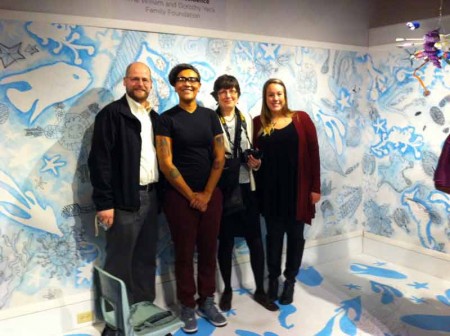
Langston Watras, art teacher at Cleveland School (Dayton Public Schools);
Jess Williams, artist and project assistant; Kate Kern; Katherine Holder, art teacher at Valerie School (DPS). Photo courtesy of the Dayton Art Institute.
Susan Byrnes: Is there a physical or psychological realm you are interested in exploring with your work?
Kate Kern: I’m interested in everyday things, so I think it’s the everyday psychological world that interests me the most. Things that go on in somebody’s mind, the layers that go on, how your memories and emotions are a real thing, and how that colors and changes everything you look at. Feelings – that world really interests me. I’m not interested in duplicating a reality, like if you see a beautiful landscape. Some artist might like to make a version of that, but I’m not interested in that. It’s more of an interior world that is equally real, but you don’t see it in the same way.
SB: How do you identify the objects that populate your “world”?
KK: I suppose they’re more images than objects. I’ve become less and less articulate, less and less able to say “oh yes here’s what I want to do”. I feel more guided by something that’s not really a word-thing, it’s more of a feeling-thing. When I encounter whatever it is that IS the thing, the idea, the image, then something just sort of leaps within me towards that. So it’s not really intellectual, it’s more of a feeling.
SB: Lets talk about “Deep SEE”. Where did the idea originate for you?
KK: It’s a combination of two things that create sparks for me, things that are juicy and interesting. One is perception, human perception, seeing and everything that might possibly involve, including not seeing, and the unseen. And then it involves the play with water, with the ocean. I know it exists, I’ve seen it, I’ve touched it, but it still remains like an unconscious… you can’t really see or experience the whole thing. You know it’s there but it feels unknowable.
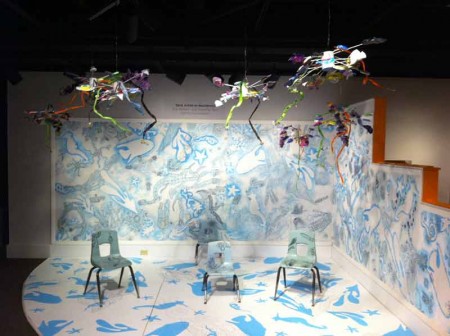
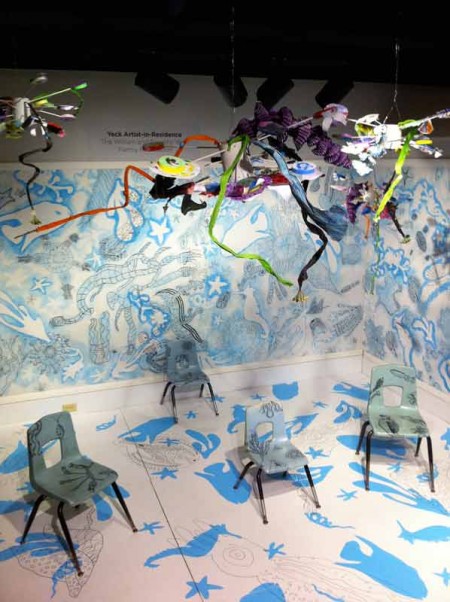
SB: Is “sea” a theme you’ve worked with before?
KK: Yes, I work with it a lot in different ways. It’s playing with the idea of interior/exterior, and bringing those two things together, much like what would happen in a dream. (In Deep SEE) there are elements that are creatures that look like they’re floating, that surround you, and then images that feel very much like a domestic space, like the chairs on a floor or decorations on a wall, like wallpaper. The things that are hanging have a creature feeling, and they could be like a chandelier light fixture.
SB: This makes me think of the interiority of Wounded Home. Would you connect Deep SEE to that?
KK: Definitely, though with completely different subject matter and feeling – almost the polar opposite in feeling. I think there’s a tenderness in both of them. There’s something very similar about the interior and the exterior, and overlapping them in terms of human experience, more so than trying to make a depiction of an interior and a landscape or an exterior.
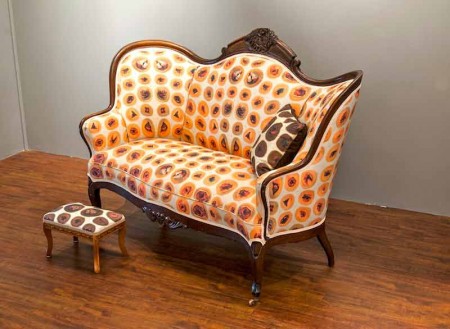
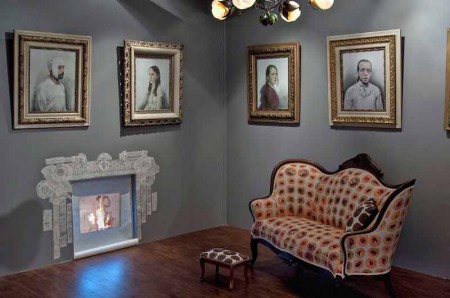

SB: What’s been one of the most challenging aspects of your career? What keeps you going?
KK: I think probably the most challenging thing is not getting discouraged over time, because you have to find a reason for why are you doing what you’re doing. If it’s looking for things like financial rewards, that’s not going to be the thing that keeps somebody like me going, that’s not going to be enough. Some of it is just stubbornness, and some of it is I’m fortunate that I CAN do it. I haven’t had pressures to choose to do something else to support my family. So it’s a combination of stubbornness and being able to find ways to keep doing what I need to do to stay on my own personal mission, but also to interact with opportunities that are available. It can be tricky, to find the right interactions, the right vehicle for what you want to do, sometimes it’s even hard to recognize.
SB: In that sense, what’s been an opportunity that you took advantage of that you wouldn’t have expect to?
KK: Originally when I applied to be an artist in residence with the Ohio Arts Council, I never thought that it would be as important as it turned out to be. It afforded so many opportunities to work with other artists, to create actual work with people on many different scales and lots of different things, and to take risks in a way that have really impacted the way I’ve been able to grow as an artist. I would not have anticipated that. It seemed like “Ok, here’s a thing I can do, and somebody will pay me. I don’t know how to do it but I’ll figure it out. “ But it’s become more than that. It has really impacted my thinking process. I think people are way more capable of understanding what seems like very deep, very complex, and very conceptual things that go on in contemporary art. They’re way more capable of interacting with that and understanding that than they’re generally given credit for. Often we, meaning artists and institutions, try to create all these little things in between them and the work to try to help them. Really, you just need to connect them and they can get it – they have that light bulb moment, and that moment when their heart leaps out towards it. Just thinking about that and having those experiences helps me to keep doing what I’m doing. I don’t feel like I’m creating something that only some really special person will understand, I feel like my work is for human beings, like it’s meant for other people and they can understand it. It’s meant to connect.
SB: Who/what are your influences?
KK: Ann Hamilton’s work, and work like that inspires me. Also other artists around me, seeing what other people are doing, and working directly with them, that’s inspirational for me, and helps give me ideas. I’m reading a book about different modalities for healing the brain. There’s a chapter on Feldenkrais (a movement therapy) in that book and that’s been really interesting, with all these secrets that make so much sense about the brain, in a non-technical way. I’m also really interested in history. Doing Wounded Home got me so deeply moved by the history of that time. Other things are tapping into history, like the musical “Hamilton”, which I haven’t seen, but just that idea is so exciting, taking a biography of an important American figure and blowing it up in this way.
SB: Tell me about your work now. You have started drawing brains?
KK: Here’s what I’ve been thinking about: the response, “I don’t know” is not a bad thing. It’s kind of interesting, the idea of “don’t know”. Not in a way of shutting down, but in a way of opening up. Opening up possibilities is the “don’t know”, and also, “I don’t understand”. It feels like there’s this pressure to know, and to say, “here are the facts”, and then back them up with this source and that source. I just don’t think like that. This idea has been in the background of my thinking process. I keep sketchbooks, and I often refer back to them. I can see this thread running through them, in a sort of apologetic way, but I’m feeling now like maybe that’s the thing.
SB: How does the way you see space betray a worldview? Your previous work has toyed with notions of faith. How does that relate to the way you use space?
KK: We’re looking at this installation (Deep SEE), which is about naming the space, or creating a context for the space, but I’m also interested in outer space, which has that floating sensation and that nice black background. I’m interested in the idea of heaven, eternity, timelessness, and the symbols of those ideas that we play around with, that are recognizable. In two-dimensional space, there is often a hierarchy of where things are positioned. What does that mean? The biggest thing is probably the most important. If it’s a big thing and it’s in the center, and there’s nothing attached to it, it kind of has that floating feeling. It looks like an icon, like a religious icon. It’s stable in a way, but also unstable because it’s not resting on anything. I like that tension. It has a meditativeness, but also a tension because not many things can float. I’ve been playing around with overlapping that idea of eternity, afterlife – not in a heavy handed way at all – time, timelessness, forgetting, memory, all those kinds of things. Overlapping them in a two-dimensional space, or even in a three-dimensional installation space, that really interests me. Using hints of stuff, like the ladder that floats, you think, where would that take you? It doesn’t have a beginning, it doesn’t have an end, and it’s different if it’s horizontal than if it’s vertical. The subject matter is not really mortality, but it’s touching on that.
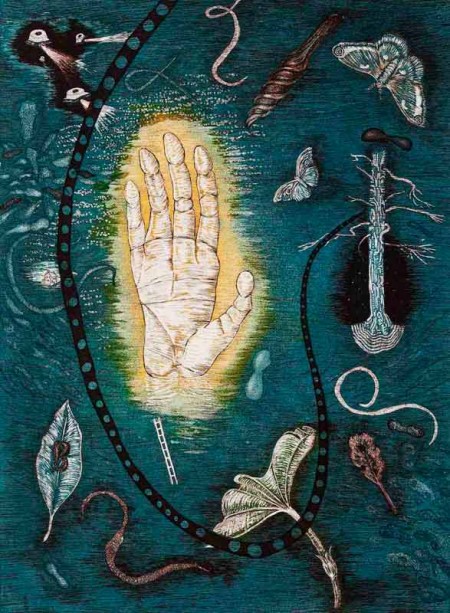
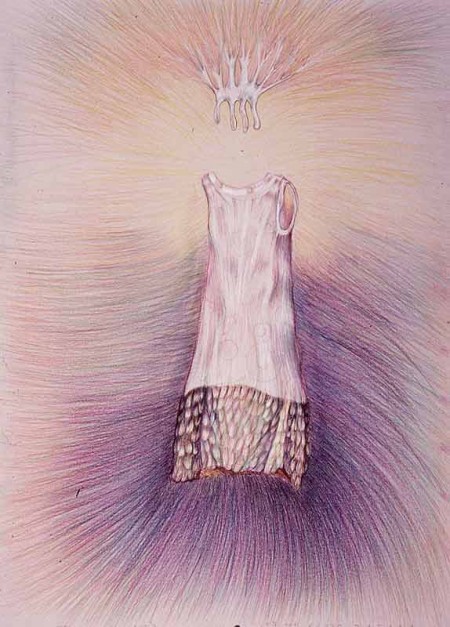
–Susan Byrnes is a visual artist whose work encompasses traditional and contemporary forms and practices, including sculpture, multimedia installation, radio broadcasts, writing, and curatorial projects. She has an MFA from Eastern Michigan University and a BFA from Syracuse University. Susan resides in Cincinnati, OH.